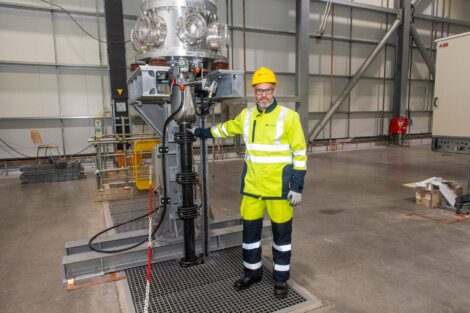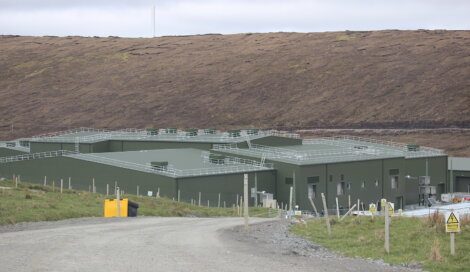Energy / Subsea power cable laid and ready to be energised in July
The Viking Energy wind farm is also due to be operational next summer
WORK on connecting Shetland to the national grid for the first time is progressing at pace – with the subsea cable to the Scottish mainland now laid in full.
Some rock protection still needs to be added to the 260km cabling, which runs between Weisdale Voe in Shetland and Noss Head in Caithness, and this could take around two months.
But SSEN Transmission’s plan is for full energisation in July next year – and the Viking Energy wind farm is due to energise then too, with that site expected to be handed over to the SSE Renewables operations team in the autumn.
Speaking during a media tour of the HVDC convertor station at Upper Kergord on Tuesday, project director John Scott said completing the laying of the cable was a big milestone.
“We’ve completed the physical burial of the cable on the seabed – we’ve trenched as much as we can, and we’re just finalising the areas which we couldn’t trench with rock protection,” he said.
“There will be a final test on that completed system once we’ve completed all that rock protection.”
The 600MW HVDC cable will allow the Viking Energy wind farm – and future renewable developments such as turbines in Yell – to export power south, and for electricity to be imported to Shetland.
Prior to that the power from wind farms needs to go through a converter station to enable it to be transmitted to the Scottish mainland.
Tucked away in Upper Kergord, the large station is located within a group of buildings which also includes an AC substation as well as infrastructure which will take in power from Viking Energy.
The whole HVDC link project is worth £660 million, with more than 200 people working on it at its peak. It is thought that it has benefitted the local economy by more than £30 million.
Become a member of Shetland News
The huge green-coloured buildings at Upper Kergord are laden with futuristic looking equipment to process the power.
Scott said the insulated switchgear in the substation will not use sulphur hexafluoride, which is very harmful if leaked – and instead it will use a “pioneering” alternative clear air system.
The system is still insulated by gas, but SSEN said the new technology is climate-neutral as it is comprised of components from clean air, which has had all its humidity and impurities removed.
As expected, there is plenty of cabling in the buildings too – 100km in total, which includes multiple cores inside. Highlighting the scale of the project, each cable needs to be checked and tested.
Despite the size of the buildings, and the scale of the equipment, the cable which runs to Caithness is incredibly modest – with the gear looking more like a drainpipe than anything.
There will not be a need for many staff once the station is operational, as the main control centre is in Perth. Only a small number of people will need to be “on call” in Shetland for in case of maintenance or emergency.
In addition to the power cables there is a separate fibre optic communications link, which Scott said should ensure reliable connectivity.
Meanwhile further south in Shetland work continues on linking Lerwick to Kergord by a mix of new trident-style overhead lines and underground cabling.
Scott said the new overhead lines are designed to be resilient in the cold weather – meaning that there should be less chance of a repeat of the significant power disruption caused by iced lines in Shetland last year.
This will tie into a new grid supply point behind the Ocean Kinetics building in town, and enable Shetland’s needs to be supplied by the new set-up.
This in turn will allow Lerwick Power Station to go into standby mode by 2025, and it is expected that the power station at Sullom Voe Terminal will also be decommissioned.
Regarding the Lerwick to Gremista project, folk driving along the A970 can see that new overhead lines being put up in the Central Mainland.
New access tracks are being constructed too.
“The next stage is to start installing the ducts that the cable will then be inserted into,” Scott said.
“We won’t physically start laying that cable until next year.”
In a phased process, Viking Energy’s 103 turbines will begin exporting energy south next year before Lerwick Power Station later goes into standby mode.
There are also three other planned wind farms in Shetland – two in Yell, and one on the outskirts of Lerwick, with the trio all being developed by Norwegian energy giant Statkraft.
With the subsea cable’s capacity at 600MW, on a very windy day in Shetland all four wind farms would exceed the limit.
In what is a complex picture, wind energy could be used – potentially – for hydrogen production.
Also in the mix are huge offshore wind farms proposed for seas to the east of Shetland.
When asked if there may ever be a case for second transmission link to the Scottish mainland, Scott said it all depends on connection requirements.
He did say that the large offshore wind projects to the east of Shetland “need to be transmitted to the national grid at some stage”.
Scott added that the National Grid is looking at solutions. “We expect some answers in early 2024 about how those are connected to the mainland,” he added.
Become a member of Shetland News
Shetland News is asking its many readers to consider paying for membership to get additional features and services: -
- Remove non-local ads;
- Bookmark posts to read later;
- Exclusive curated weekly newsletter;
- Hide membership messages;
- Comments open for discussion.
If you appreciate what we do and feel strongly about impartial local journalism, then please become a member of Shetland News by either making a single payment, or setting up a monthly, quarterly or yearly subscription.








































































